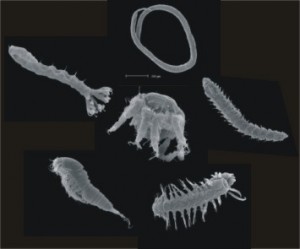
You wouldn’t think there would be any life in our desert like beach; sure there’s a lot of life on the beach – various kinds of shore birds; some evil biting beach fleas in the seaweed; people; loose dogs – but in the sand? How could anything live in the sand?
But tiny creatures not only live there, they thrive in the tiny spaces between grains of sand that also hold water. And they are small – so small they fit between netting that with openings only half a millimeter to a millimeter.
How big is that? Take out a ruler and look at the metric side – you’re probably looking at centimeters; it takes 10 millimeters to make one centimeter – you can see just how small these creatures are.
Most of these tiny creatures – marine biologists call them meiofauna to describe their size – live on organic matter – seaweed and animals – and aid in their decay. They can move, using the film of water which surrounds the particles of sand. They have adapted to live in one of the harshest environments for life on the surface of the planet. They have to be able to live with the salt water high tides that alternate with exposure to the sun heated drier sand at low tide.
They can move, using the film of water which surrounds the particles of sand. They have adapted to live in one of the harshest environments for life on the surface of the planet. They have to be able to live with the salt water high tides that alternate with exposure to the sun heated drier sand at low tide.
They have adapted to narrow spaces through miniaturization, elongation and flexibility; to the mobile environment –special ways of moving, and to the three-dimensional dark conditions.
And of course they are tiny parts of the food chain, aiding in the decay of seaweed, as well as tiny bits of clams, crabs or the like left by the seagulls; then they in turn are food for infant fish when tides wash over their beach area.
They also reproduce rapidly and are extremely sensitive to pollution since most pollutants are found in the sediments these animals live in, and so increasingly they have been used for pollution monitoring, especially since meiofauna have such short life cycles.
And so meiofauna are part of our beach environment cleaning the beach of decaying organic matter and part of the complicated food chain here. Of course they can be crushed by trucks on the beach or killed by dog urine and dog feces – another reason to keep our beach, at least in the summer, truck and dog free.
